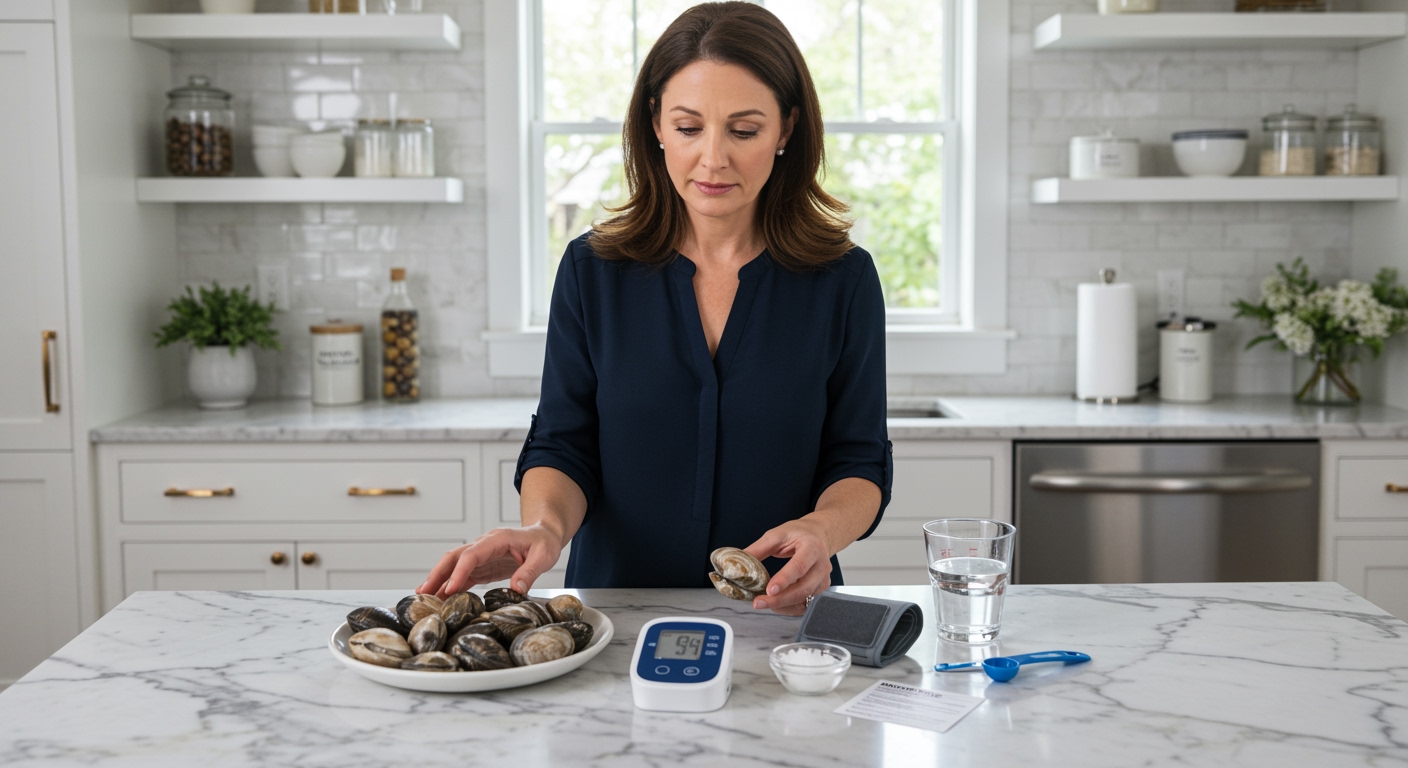✪ Key Takeaway: Clams contain high sodium levels that can raise blood pressure, but their potassium and magnesium may help balance this effect.
Introduction
You walk into a seafood restaurant and see clams on the menu, wondering if they will spike your blood pressure.
Many people with low blood pressure or those monitoring their cardiovascular health ask this question because shellfish have a complex nutritional profile that affects circulation in different ways.
Hi, I am Abdur, your nutrition coach and today I am going to explain exactly how clams impact your blood pressure and what you need to know before adding them to your diet.
Do Clams Contain High Sodium Levels?
Clams naturally contain significant amounts of sodium that can influence your blood pressure readings.
A 3-ounce serving of cooked clams provides approximately 95 milligrams of sodium, which represents about 4% of the daily recommended limit.
This sodium content comes from the marine environment where clams live, as they filter seawater through their bodies and naturally concentrate minerals.
The sodium in clams can cause your body to retain more water, which increases blood volume and puts additional pressure on your arterial walls.
However, the sodium content in clams is relatively moderate compared to processed foods like canned soups or deli meats that contain 600-1000 milligrams per serving.
Your kidneys work to balance sodium levels by either retaining or excreting it through urine, but this process can be overwhelmed when you consume too much sodium throughout the day.
✪ Fact: Fresh clams contain less sodium than canned or processed varieties which often have added salt.
What Other Minerals Do Clams Provide?
Clams deliver an impressive array of blood pressure-supporting minerals that work to counteract sodium effects.
A single 3-ounce serving provides about 534 milligrams of potassium, which helps your kidneys eliminate excess sodium and relaxes blood vessel walls.
The magnesium content in clams reaches approximately 15 milligrams per serving, supporting smooth muscle relaxation in your arteries and promoting better blood flow.
Clams also contain meaningful amounts of calcium and iron, both of which play roles in maintaining healthy circulation and oxygen transport.
These minerals work together in what nutritionists call a synergistic effect, where the combination provides greater benefits than any single mineral alone.
The potassium-to-sodium ratio in clams is approximately 5.6:1, which falls within the range that many cardiologists recommend for cardiovascular health.
✪ Pro Tip: Pair clams with potassium-rich vegetables like spinach or tomatoes to maximize blood pressure benefits.
How Do Clams Affect People With Low Blood Pressure?
People with low blood pressure may actually benefit from the moderate sodium content in clams when consumed as part of a balanced diet.
Low blood pressure, or hypotension, occurs when your systolic pressure drops below 90 mmHg or diastolic pressure falls under 60 mmHg.
The sodium in clams can help increase blood volume slightly, which may bring blood pressure readings into a more normal range for hypotensive individuals.
However, the effect is typically mild and temporary, lasting only a few hours after consumption before your kidneys adjust fluid balance.
The protein content in clams, which reaches about 25 grams per serving, also supports healthy blood vessel function and may help maintain steady blood pressure.
People with severe hypotension should work with their healthcare provider to determine if dietary sodium increases are appropriate for their specific condition.
✪ Note: Always monitor your blood pressure response when making dietary changes, especially if you have hypotension.
What About Preparation Methods and Blood Pressure?
The way you prepare clams significantly impacts their final sodium content and potential blood pressure effects.
Steaming fresh clams without added salt keeps sodium levels at their natural baseline, while adding butter, garlic, and herbs enhances flavor without increasing sodium intake.
Breaded and fried clam preparations can triple the sodium content due to seasoned coatings and the salt used in commercial breading mixtures.
Canned clams often contain added sodium as a preservative, with some varieties providing up to 300 milligrams of sodium per serving.
Restaurant preparations frequently include high-sodium ingredients like soy sauce, worcestershire sauce, or seasoned broths that can push total sodium well above healthy limits.
Rinsing canned clams under cold water for 30 seconds can reduce sodium content by approximately 25-30 percent according to food science research.
✪ Pro Tip: Choose fresh or frozen clams over canned varieties to control sodium intake more effectively.
Should You Include Clams in Your Diet?
Most people can safely include clams in their diet 1-2 times per week without significantly impacting blood pressure when prepared properly.
The high protein content and beneficial minerals in clams make them a nutritious choice for people seeking to diversify their seafood intake.
People with hypertension should limit portion sizes to 3-4 ounces and avoid high-sodium preparation methods like breading or heavy sauces.
Those with kidney disease or severe hypertension should consult their healthcare provider before adding clams to their meal plan due to the mineral content.
The omega-3 fatty acids in clams, though present in smaller amounts than in fish, still contribute to overall cardiovascular health and may help reduce inflammation.
Balance is key when incorporating any food into your diet, and clams work best as part of a varied eating pattern that includes plenty of vegetables and whole grains.
✪ Fact: Clams provide more iron per serving than most red meats while delivering heart-healthy minerals.
The Bottom Line
Clams can have a mild blood pressure raising effect due to their sodium content, but their potassium and magnesium help balance this impact for most people.
Smart food choices come from understanding the complete nutritional picture, not just focusing on single nutrients.
I would love to hear about your experiences with seafood and blood pressure management, so please share your thoughts or questions in the comments below.
References
At NutritionCrown, we use quality and credible sources to ensure our content is accurate and trustworthy. Below are the sources referenced in creating this article:
- PMC: Dietary Sodium and Cardiovascular Health
- PMC: Seafood Consumption and Blood Pressure
- Harvard Health: Seafood Selections for Heart Health
- Fulton Fish Market: DASH Diet and Seafood





